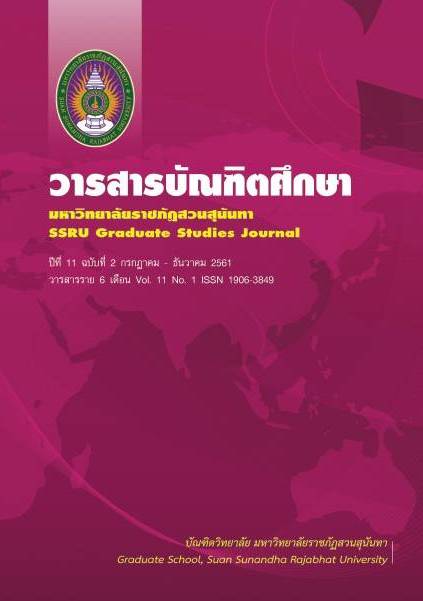The 21st Century Leadership Components and Indicator of the School Administrators under the Primary Educational Service Area Office in the Western Region of Thailand
Main Article Content
Abstract
The objectives of this research were to: 1) study the 21st century leadership components and indicators for the school administrators under the Primary Educational Service Area Office of the Western region of Thailand; and 2) examine the concurrent validity of the 21st century leadership indicators of the school administrators. The research sample consisted of 906 school administrators, deputies of the school administrators, and heads of the departments. A questionnaire was used as the research instrument. Eigen values of each main factors were considered. Factor extraction was conducted with the orthogonal rotation through Varimax method. Concurrent validity was confirmed by analyzing components and indicators to determine mean () and standard deviation. Mean values were tested with t-test.
The results of this study showed that there were 9 components and 88 indicators of the 21st leadership of the school administrators including: 1) communication; 2) moral and ethics; 3) vision; 4) interaction; 5) sustainability; 6) omniscience; 7) personnel development; 8) decision making; and 8) changes. Cronbach’s Alpha Coefficient (reliability) was 0.964. Exploratory factor analysis was conducted by considering Eigen values of each main factors. Orthogonal rotation was done through Varimax method to gain a new set of 12 new components including: 1) being a planner; 2) social skills; 3) personnel development; 4) omniscience; 5) conduct; 6) self-development; 7) decision making; 8) flexibility; 9) change; 10) situational management; 11) vision; 12) problem solving. Furthermore, a new set of 78 indicators were also determined. These indicators that could explain the variation up to 61.859 per cent. The results of the concurrent validity testing showed that mean values () ranged from 4.07 - 4.73. When testing the results with t-test by comparing mean and population mean (µ = 3.50) based on criterion concurrent validity, it was found that the mean values of all the indicators were different from the population mean with a statistical significance level of .001.
Article Details
References
ทวีศักดิ์ จินดานุรักษ์. (2559). การจัดการศึกษา 4.0 กับการพัฒนาประเทศที่ยั่งยืน. [ออนไลน์]. สืบค้นเมื่อกรกฎาคม 21, 2560, จาก http://adacstou.wixsite.com/adacstou/singlepost/2017/09/01.
พรชัย เจดามาน. (2559). บทความสมรรถนะแห่งตน : การพัฒนาตนเองของบุคลากรการศึกษาที่ก้าวทัน การเปลี่ยนแปลงในทศวรรษที่ 21. (ออนไลน์). สืบค้นเมื่อ กรกฎาคม 25, 2560, จาก http://personnel.obec.go.th/home/wp-content/uploads/2016/05.pdf?module=upload_config%22.
สถาพร พฤฑฒิกุล. (2560). การบริหารการศึกษากับการเปลี่ยนแปลงในศตวรรษที่ 21. วารสารศึกษาศาสตร์. 28(2), พฤษภาคม - สิงหาคม 2560.
สำนักงานคณะกรรมการการศึกษาขั้นพื้นฐาน. (2560). คู่มือการพัฒนาข้าราชการครูและบุคลากรทางการศึกษาก่อนแต่งตั้งให้ดำรงตำแหน่งผู้อำนวยการสถานศึกษา. กรุงเทพฯ: สำนักงานพัฒนาครูและบุคลากรทางการศึกษา กระทรวงศึกษาธิการ.
สำนักงานศึกษาธิการภาค 4. (2558). ยุทธศาสตร์การพัฒนาการศึกษาในพื้นที่. (ออนไลน์). สืบค้นเมื่อ กรกฎาคม 24, 2560, จาก http://www.reo4.moe.go.th/web/images/stories/startegy/7.pdf.
สุวิมล ว่องวาณิช. (2550). การวิจัยประเมินความต้องการจาเป็น (พิมพ์ครั้งที่ 2). กรุงเทพฯ: จุฬาลงกรณ์มหาวิทยาลัย.
เสริมศักดิ์ วิศาลาภรณ์ และคณะ. (2555). ความเที่ยงตรงตามเนื้อหา. สารานุกรมวิชาชีพครู เฉลิมพระเกียรติพระบาทสมเด็จพระเจ้าอยู่หัวเนื่องในโอกาสพระราชพิธีมหามงคลเฉลิมพระชนมหาพรรษา 7 รอบ 5 ธันวาคม 2554. กรุงเทพฯ: สกสค. ลาดพร้าว.
โสภณ ภูเก้าล้วน. (2559). ความสำคัญของการรักษาดุลยภาพ. [ออนไลน์]. สืบค้นเมื่อ ธันวาคม 9 ,2560, จาก https://www.siamrath.co.th/n/2892.
Bersin, J. (2012). It’s not the CEO, It’s the leadership strategy that matter. Forbs Magazine.
Best, J. W. (1978). Research in Education. Englewood Cliffs, New Jersey: Prentice Hall.
Bohlander, G., Snell, S. & Sherman, A. (2001). Managing Human Resources (12 th ed.). Ohio: South– Western College.
Hair, J. F., Black, W. C., Babin, B. J., & Anderson, R. E. (2010). Multivariate data analysis: A global perspective. Upper Saddle River, NJ: Pearson.
Krejcie, R.V., & D.W. Morgan. (1970). Determining Sample Size for Research Activities. Educational and Psychological Measurement. 30(3), 607 – 610.
Meister, J.C. (2010). The 2020 Leadership Model for Tomorrow’s workplace. Harper Collins Publish.


